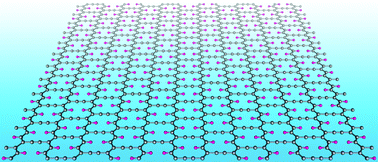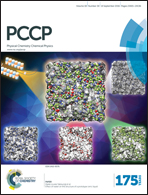First-principles prediction of a new planar hydrocarbon material: half-hydrogenated 14,14,14-graphyne
Abstract
Graphynes, novel allotropic forms of carbon, have become a rising star in two-dimensional materials science due to the diverse geometric structures and excellent electronic properties. In this paper, first-principles calculations were performed to investigate a favorable path for successive hydrogenation of 14,14,14-graphyne and electronic properties of the resulting novel planar structure. Pairs of hydrogen atoms prefer to arrange themselves on opposite sides of acetylenic bonds within the basal plane due to the collective stabilization mediated by cooperative buckling of the original linear acetylenic chains. Progressive hydrogenation favors proceeding along linear directions in a row-by-row manner. A new strictly planar sp–sp2-bonded hydrocarbon is formed when half of the sp-hybridized carbon atoms in the chains are hydrogenated. In contrast to the zero-band-gap feature of pristine 14,14,14-graphyne, this hydrocarbon possesses a moderate direct band gap. A possible experimental realization of the proposed two-dimensional hydrocarbon was also discussed. This novel planar hydrocarbon material can not only broaden the application field of graphyne family in electronic and optoelectronic devices but also enrich the databases of carbon-based two-dimensional materials.



 Please wait while we load your content...
Please wait while we load your content...